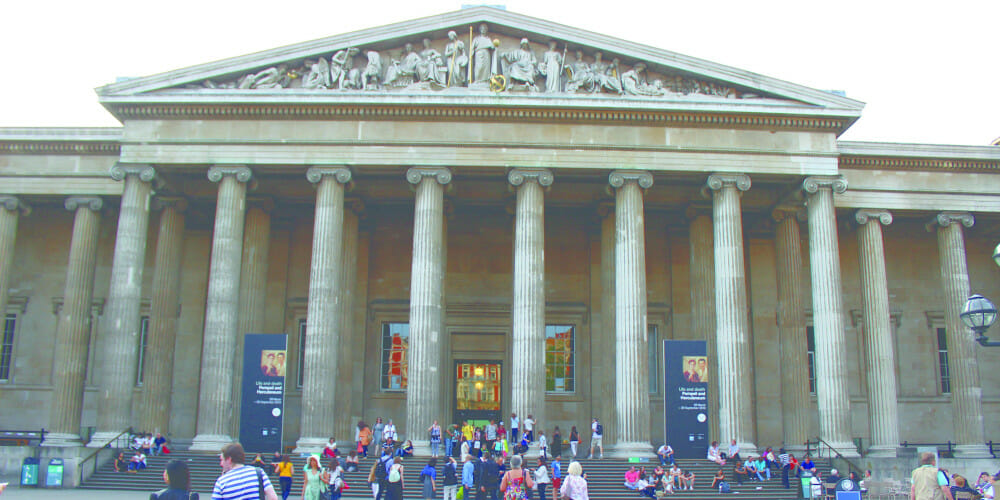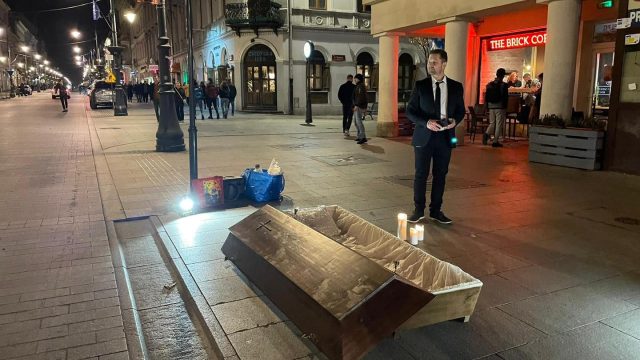A unique approach

Hi! I’m leading a free tour of the top seven attractions of the British Museum. We’re going to look at 4,000 years in 45 minutes. We’ll be leaving in five minutes. No tips accepted.” I stood on the front steps of one of the most prestigious archaeological museums in the world, recruiting visitors to check out my tour.
“What’s the catch?” everyone wanted to know.
“I’m a student finishing up my master’s degree,” I explained. “I just spent two months doing archaeological research in Greece and Turkey. I have a week here in London before I go back to the United States to finish my studies, so I thought I would share a bit of what I’ve discovered.”
What they didn’t know was that I was in London for a mission trip with my wife, Caitlin; brother, Jakob Serns; dad, Dan Serns; and friend Austin McKey. In the mornings our small team distributed thousands of Bible tracts to the masses in tourist areas. In the evenings we partnered with a local church to help start Bible studies in their neighborhood. In the afternoons I led evangelistic tours through the British Museum. Jakob was my “tour assistant,” Caitlin was the photographer, and Dan and Austin played the roles of tour participants. We prayed that God would use the tours to open people’s hearts to His Word.
Growing Groups
People joined the tours, which ranged from eight to 45 participants. That week we led more than 400 people on 12 tours through the British Museum.
My “Top Seven Attractions Tour” looked at an artifact from each of the major Western world civilizations: (1) Egypt, (2) Assyria, (3) Babylon, (4) Persia, (5) Greece, (6) Rome, and (7) divided Europe. My goal was to use history and archaeology to gradually validate the Bible as God’s Word. For Egypt and Assyria I drew connections to Joseph and Hezekiah. At the artifacts from Babylon I presented the great image of Daniel 2. Throughout the rest of the tour we saw the prophecy fulfilled artifact by artifact. At the end I shared how Bible prophecy continues into the future. I encouraged my tour group to check out Daniel 2 in the Bible to see what comes next. We also offered free sets of Amazing Facts Bible study guides for further study.
We had people from many different countries, cultures, and faith backgrounds. Some of our tour participants came from countries in which it is illegal to speak openly about subjects that I presented on the tour. It was thrilling to see God opening people’s minds and challenging their worldviews.
Lessons From Hezekiah
When my tour group got to the Lachish reliefs from Assyria, I told the story about King Sennacherib. His goal was to take over Israel (Judah) and prove himself stronger than Israel’s God. His conquest was wildly successful. He captured town after town in Israel—46 cities in all. Lachish was the last stop before Israel’s capital at Jerusalem. The Lachish reliefs depict the story of Sennacherib’s absolute devastation of the Israelites at the battle of Lachish. Now nothing stood in the way of the Assyrians taking down the capital and nation.
Sennacherib’s 185,000 soldiers surrounded Jerusalem in a siege. They sent a nasty letter threatening the people of Israel. “Don’t listen to your God! He can’t save you! Don’t listen to your king! He can’t save you either! You might as well surrender now!”
King Hezekiah received the letter with distress. He brought it into the Temple and stretched it out before the God of Israel. He prayed, “God, You chose us as a nation to represent Your character to the nations around us. Consider these threats from our enemies who claim they are stronger than You. Now, O Lord, deliver us, so that all the kingdoms on earth may know that You alone are God” (see 2 Kings 19).
Then I showed tour participants the Taylor Prism, which tells Sennacherib’s side of the story. Sennacherib’s inscription says that he took 46 cities in Israel and locked up King Hezekiah in Jerusalem “like a bird in a cage.” So why did he stop? Why did he leave?
The morning after Hezekiah’s prayer, all of Sennacherib’s 185,000 soldiers surrounding the city of Jerusalem were found dead. “You decide how they died,” I said, “but I can tell you that it was not by Israelite soldiers.” Some were shocked as they were compelled to intelligently consider a God who miraculous intervenes in human history.
Later on the tour, a woman from England asked me, “Do you really believe the Bible is the Word of God?”
“Well, that’s what the Bible itself claims,” I said. “It’s a unique and bold claim. It’s either a complete lie, or it’s true. From everything I have studied, the evidence seems to suggest that it’s true.” The artifacts right before her eyes were confronting her to seriously consider—possibly for the first time—that there could be a God who communicates with people in a clear, reliable, and accessible way.
Meeting Resistance
God was working through the tours. It didn’t take long, however, before we met some resistance. The British Museum staff began noticing us. The museum offers its own free tours, usually with no more than a half dozen participants. Who was this guy leading hordes of people through the museum a couple times each afternoon? I was openly sharing some unpopular biblical ideas. So we began receiving increased attention from the museum staff, and tension was building. Finally, halfway through the week, there was a confrontation.
My 40 tour participants and I crowded in front of the statue of Aphrodite, the Greek goddess of sex. I explained about the Temple of Aphrodite in Corinth, which hosted anywhere from 300 to 1,000 temple prostitutes. I shared about a newcomer to town named Paul who gave the Corinthians some startling new ideas about sex and started reading the story from the Bible (see 1 Cor. 6). Out of the corner of my eye I could see the museum staff member looking more and more uncomfortable. “Paul believed that people can change, not by their own power but by the power of Jesus Christ, who, he claimed, had died and resurrected and was the Savior of humanity,” I continued. The words were scarcely out of my mouth when the staff member came swooping in.
“Stop! Stop! You can can’t do this here!” he interrupted, looking upset. I wondered if this was the end of my British Museum tours. Then he said, “You’re blocking the way.”
I realized what was happening. He didn’t have authority over what I said, only whether or not people blocked the walkway. Our group was too big for the small area. So I answered, “No problem; we were about to head to the next artifact anyway.” Turning to the tour participants, I said, “Let’s go over to the Rosetta stone.”
Two “undercover” museum staff members joined our tour that afternoon. I noticed the radios hidden under their jackets. At the end of the tour one of the guards was the first to give an enthusiastic applause. He then said, “This was one of the best presentations I have ever heard! I have never heard history and the Bible blended in that way!” A couple days later I gave him a copy of Ellen White’s book The Great Hope.
We never had another problem at the museum throughout the rest of the week. God made sure His Word was heard. God speaks to anyone who will listen. He speaks through the Bible. He speaks through history and archaeology. He speaks through people—even a teenage-looking, unofficial tour guide and his team in a famous museum. God will make sure His Word is heard. Will you let Him speak through you?
Check out basic video recordings of the tour online at www.youtube.com/top7tours.








